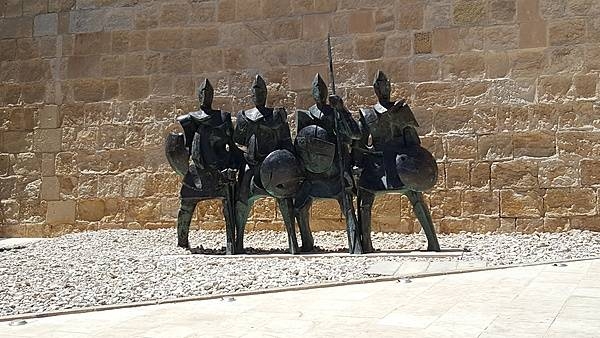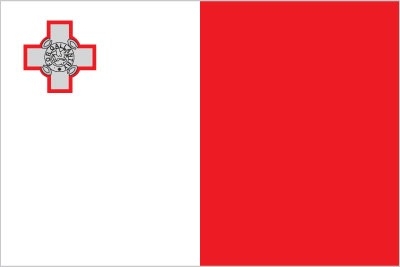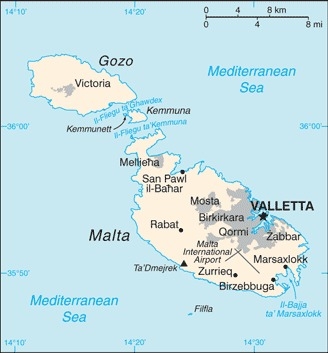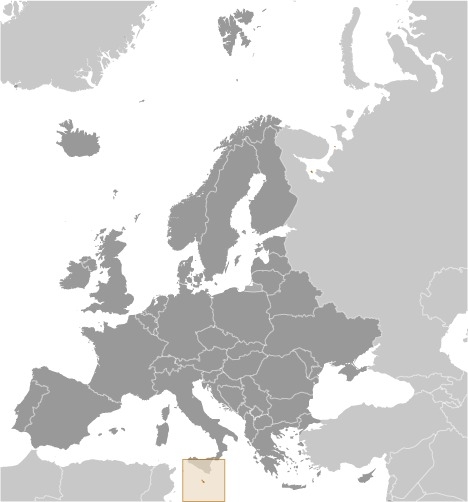Introduction
Background
With a civilization that dates back thousands of years, Malta boasts some of the oldest megalithic sites in the world. Situated in the center of the Mediterranean, Malta’s islands have long served as a strategic military asset, with the islands at various times having come under control of the Phoenicians, Carthaginians, Greeks, Romans, Byzantines, Moors, Normans, Sicilians, Spanish, Knights of St. John, and the French. Most recently a British colony (since 1814), Malta gained its independence in 1964 and declared itself a republic ten years later. While under British rule, the island staunchly supported the UK through both world wars. Since about the mid-1980s, the island has transformed itself into a freight transshipment point, a financial center, and a tourist destination while its key industries moved toward more service-oriented activities. Malta became an EU member in May 2004 and began using the euro as currency in 2008.
Visit the Definitions and Notes page to view a description of each topic.
Geography
Location
Southern Europe, islands in the Mediterranean Sea, south of Sicily (Italy)
Geographic coordinates
35 50 N, 14 35 E
Map references
Europe
Land boundaries
total: 0 km
Coastline
196.8 km (excludes 56 km for the island of Gozo)
Maritime claims
territorial sea: 12 nm
contiguous zone: 24 nm
continental shelf: 200-m depth or to the depth of exploitation
exclusive fishing zone: 25 nm
Climate
Mediterranean; mild, rainy winters; hot, dry summers
Terrain
mostly low, rocky, flat to dissected plains; many coastal cliffs
Elevation
highest point: Ta'Dmejrek on Dingli Cliffs 253 m
lowest point: Mediterranean Sea 0 m
Natural resources
limestone, salt, arable land
Land use
agricultural land: 32.3% (2018 est.)
arable land: 28.4% (2018 est.)
permanent crops: 3.9% (2018 est.)
permanent pasture: 0% (2018 est.)
forest: 0.9% (2018 est.)
other: 66.8% (2018 est.)
Irrigated land
35 sq km (2012)
Population distribution
most of the population lives on the eastern half of Malta, the largest of the three inhabited islands
Natural hazards
occasional droughts
Geography - note
the country comprises an archipelago, with only the three largest islands (Malta, Ghawdex or Gozo, and Kemmuna or Comino) inhabited; numerous bays provide good harbors; Malta and Tunisia are discussing oil exploration on the continental shelf between their countries, although no commercially viable reserves have been found as of 2017
People and Society
Nationality
noun: Maltese (singular and plural)
adjective: Maltese
Ethnic groups
Maltese (descendants of ancient Carthaginians and Phoenicians with strong elements of Italian and other Mediterranean stock)
Languages
Maltese (official) 90.1%, English (official) 6%, multilingual 3%, other 0.9% (2005 est.)
Religions
Roman Catholic (official) more than 90% (2006 est.)
Age structure
0-14 years: 14.38% (male 33,934/female 31,823)
15-24 years: 10.33% (male 24,445/female 22,811)
25-54 years: 41.1% (male 97,685/female 90,264)
55-64 years: 12.88% (male 29,533/female 29,353)
65 years and over: 21.3% (male 44,644/female 52,775) (2020 est.)
Dependency ratios
total dependency ratio: 55.5
youth dependency ratio: 22.4
elderly dependency ratio: 33.2
potential support ratio: 3 (2020 est.)
Median age
total: 42.3 years
male: 41.2 years
female: 43.5 years (2020 est.)
Population distribution
most of the population lives on the eastern half of Malta, the largest of the three inhabited islands
Urbanization
urban population: 94.8% of total population (2021)
rate of urbanization: 0.28% annual rate of change (2020-25 est.)
Major urban areas - population
213,000 VALLETTA (capital) (2018)
Sex ratio
at birth: 1.04 male(s)/female
0-14 years: 1.07 male(s)/female
15-24 years: 1.07 male(s)/female
25-54 years: 1.08 male(s)/female
55-64 years: 1.01 male(s)/female
65 years and over: 0.85 male(s)/female
total population: 1.01 male(s)/female (2020 est.)
Mother's mean age at first birth
29 years (2019 est.)
note: data refer to the average of the different childbearing ages of first-order births
Maternal mortality ratio
6 deaths/100,000 live births (2017 est.)
country comparison to the world: 161Infant mortality rate
total: 4.62 deaths/1,000 live births
male: 4.51 deaths/1,000 live births
female: 4.73 deaths/1,000 live births (2021 est.)
Life expectancy at birth
total population: 83 years
male: 80.91 years
female: 85.19 years (2021 est.)
Drinking water source
improved: urban: 100% of population
rural: 100% of population
total: 100% of population
unimproved: urban: 0% of population
rural: 0% of population
total: 0% of population (2017 est.)
Current Health Expenditure
9% (2018)
Physicians density
2.86 physicians/1,000 population (2015)
Hospital bed density
4.5 beds/1,000 population (2017)
Sanitation facility access
improved: urban: 100% of population
rural: 100% of population
total: 100% of population
unimproved: urban: 0% of population
rural: 0% of population
total: 0% of population (2017 est.)
HIV/AIDS - people living with HIV/AIDS
<500 (2016 est.)
HIV/AIDS - deaths
<100 (2016 est.)
Literacy
definition: age 15 and over can read and write
total population: 94.5%
male: 93%
female: 96% (2018)
School life expectancy (primary to tertiary education)
total: 17 years
male: 16 years
female: 17 years (2019)
Unemployment, youth ages 15-24
total: 10.7%
male: 13.1%
female: 8% (2020 est.)
Environment
Environment - current issues
limited natural freshwater resources; increasing reliance on desalination; deforestation; wildlife preservation
Environment - international agreements
party to: Air Pollution, Biodiversity, Climate Change, Climate Change-Kyoto Protocol, Climate Change-Paris Agreement, Comprehensive Nuclear Test Ban, Desertification, Endangered Species, Hazardous Wastes, Law of the Sea, Marine Dumping-London Convention, Nuclear Test Ban, Ozone Layer Protection, Ship Pollution, Tropical Timber 2006, Wetlands
signed, but not ratified: none of the selected agreements
Air pollutants
particulate matter emissions: 13.97 micrograms per cubic meter (2016 est.)
carbon dioxide emissions: 1.34 megatons (2016 est.)
methane emissions: 0.2 megatons (2020 est.)
Climate
Mediterranean; mild, rainy winters; hot, dry summers
Land use
agricultural land: 32.3% (2018 est.)
arable land: 28.4% (2018 est.)
permanent crops: 3.9% (2018 est.)
permanent pasture: 0% (2018 est.)
forest: 0.9% (2018 est.)
other: 66.8% (2018 est.)
Urbanization
urban population: 94.8% of total population (2021)
rate of urbanization: 0.28% annual rate of change (2020-25 est.)
Revenue from forest resources
forest revenues: 0% of GDP (2018 est.)
country comparison to the world: 184Waste and recycling
municipal solid waste generated annually: 269,000 tons (2015 est.)
municipal solid waste recycled annually: 17,996 tons (2015 est.)
percent of municipal solid waste recycled: 6.7% (2015 est.)
Total water withdrawal
municipal: 37.4 million cubic meters (2017 est.)
industrial: 1 million cubic meters (2017 est.)
agricultural: 25.4 million cubic meters (2017 est.)
Total renewable water resources
50.5 million cubic meters (2017 est.)
Government
Country name
conventional long form: Republic of Malta
conventional short form: Malta
local long form: Repubblika ta' Malta
local short form: Malta
etymology: the ancient Greeks called the island "Melite" meaning "honey-sweet" from the Greek word "meli" meaning "honey" and referring to the island's honey production
Government type
parliamentary republic
Capital
name: Valletta
geographic coordinates: 35 53 N, 14 30 E
time difference: UTC+1 (6 hours ahead of Washington, DC, during Standard Time)
daylight saving time: +1hr, begins last Sunday in March; ends last Sunday in October
etymology: named in honor of Jean de Valette, the Grand Master of the Order of Saint John (crusader knights), who successfully led a defense of the island from an Ottoman invasion in 1565
Administrative divisions
68 localities (Il-lokalita); Attard, Balzan, Birgu, Birkirkara, Birzebbuga, Bormla, Dingli, Fgura, Floriana, Fontana, Ghajnsielem, Gharb, Gharghur, Ghasri, Ghaxaq, Gudja, Gzira, Hamrun, Iklin, Imdina, Imgarr, Imqabba, Imsida, Imtarfa, Isla, Kalkara, Kercem, Kirkop, Lija, Luqa, Marsa, Marsaskala, Marsaxlokk, Mellieha, Mosta, Munxar, Nadur, Naxxar, Paola, Pembroke, Pieta, Qala, Qormi, Qrendi, Rabat, Rabat (Ghawdex), Safi, San Giljan/Saint Julian, San Gwann/Saint John, San Lawrenz/Saint Lawrence, Sannat, San Pawl il-Bahar/Saint Paul's Bay, Santa Lucija/Saint Lucia, Santa Venera/Saint Venera, Siggiewi, Sliema, Swieqi, Tarxien, Ta' Xbiex, Valletta, Xaghra, Xewkija, Xghajra, Zabbar, Zebbug, Zebbug (Ghawdex), Zejtun, Zurrieq
Independence
21 September 1964 (from the UK)
National holiday
Independence Day, 21 September (1964); Republic Day, 13 December (1974)
Constitution
history: many previous; latest adopted 21 September 1964
amendments: proposals (Acts of Parliament) require at least two-thirds majority vote by the House of Representatives; passage of Acts requires majority vote by referendum, followed by final majority vote by the House and assent of the president of the republic; amended many times, last in 2020
Legal system
mixed legal system of English common law and civil law based on the Roman and Napoleonic civil codes; subject to European Union law
International law organization participation
accepts compulsory ICJ jurisdiction with reservations; accepts ICCt jurisdiction
Citizenship
citizenship by birth: no
citizenship by descent only: at least one parent must be a citizen of Malta
dual citizenship recognized: no
residency requirement for naturalization: 5 years
Suffrage
18 years of age (16 in local council elections); universal
Executive branch
chief of state: President George VELLA (since 4 April 2019)
head of government: Prime Minister Robert ABELA (13 January 2020)
cabinet: Cabinet appointed by the president on the advice of the prime minister
elections/appointments: president indirectly elected by the House of Representatives for a single 5-year term; election last held on 2 April 2019 (next to be held by April 2024); following legislative elections, the leader of the majority party or majority coalition usually appointed prime minister by the president for a 5-year term; deputy prime minister appointed by the president on the advice of the prime minister
election results: George VELLA (PL) elected president; House of Representatives vote - unanimous; Robert ABELA (PL) appointed prime minister
Legislative branch
description: unicameral House of Representatives or Il-Kamra Tad-Deputati, a component of the Parliament of Malta (normally 65 seats but can include at-large members; members directly elected in 5 multi-seat constituencies by proportional representation vote; members serve 5-year terms); note - an additional two seats were added in 2016 by the Constitutional Court to correct for mistakes made in the 2013 vote-counting process
elections: last held on 3 June 2017 (next to be held on 31 July 2022); note - Prime Minister MUSCAT called for early elections amid corruption allegations
election results: percent of vote by party - PL 55%, PN 43.7%, other 1.3%; seats by party - PL 37 PN 30; note - PN was awarded two additional seats for a total of 30 in accordance with the proportionality provisions specified in the constitution; PD candidates ran under the PN list; composition - men 57, women 10, percent of women 14.9%
Judicial branch
highest courts: Court of Appeal (consists of either 1 or 3 judges); Constitutional Court (consists of 3 judges); Court of Criminal Appeal (consists of either 1 or 3 judges)
judge selection and term of office: Court of Appeal and Constitutional Court judges appointed by the president, usually upon the advice of the prime minister; judges of both courts serve until age 65
subordinate courts: Civil Court (divided into the General Jurisdiction Section, Family Section, and Voluntary Section); Criminal Court; Court of Magistrates; Gozo Courts (for the islands of Gozo and Comino)
Political parties and leaders
Democratic Party (Partit Demokratiku) or PD [Godfrey FARRUGIA]
Labor Party (Partit Laburista) or PL [Robert ABELA]
Nationalist Party (Partit Nazzjonalista) or PN [Bernard GRECH]
International organization participation
Australia Group, C, CD, CE, EAPC, EBRD, ECB, EIB, EMU, EU, FAO, IAEA, IBRD, ICAO, ICC (NGOs), ICCt, ICRM, IDA, IFAD, IFC, IFRCS, ILO, IMF, IMO, IMSO, Interpol, IOC, IOM, IPU, ISO, ITSO, ITU, ITUC (NGOs), MIGA, NSG, OAS (observer), OPCW, OSCE, PCA, PFP, Schengen Convention, UN, UNCTAD, UNESCO, UNIDO, Union Latina (observer), UNWTO, UPU, WCO, WHO, WIPO, WMO, WTO
Diplomatic representation in the US
chief of mission: Ambassador Keith AZZOPARDI (since 17 September 2018)
chancery: 2017 Connecticut Avenue NW, Washington, DC 20008
telephone: [1] (202) 462-3611; [1] (202) 462-3612
FAX: [1] (202) 387-5470
email address and website:
maltaembassy.washington@gov.mt
https://foreignandeu.gov.mt/en/Embassies/ME_United_States/Pages/ME_United_States.aspx
Diplomatic representation from the US
chief of mission: Ambassador (vacant); Charge d'Affaires Gwendolyn "Wendy" GREEN (since August 2020)
embassy: Ta' Qali National Park, Attard, ATD 4000
mailing address: 5800 Valletta Place, Washington DC 20521-5800
telephone: [356] 2561-4000
email address and website:
ACSMalta@state.gov
https://mt.usembassy.gov/
Flag description
two equal vertical bands of white (hoist side) and red; in the upper hoist-side corner is a representation of the George Cross, edged in red; according to legend, the colors are taken from the red and white checkered banner of Count Roger of Sicily who removed a bi-colored corner and granted it to Malta in 1091; an uncontested explanation is that the colors are those of the Knights of Saint John who ruled Malta from 1530 to 1798; in 1942, King George VI of the UK awarded the George Cross to the islanders for their exceptional bravery and gallantry in World War II; since independence in 1964, the George Cross bordered in red has appeared directly on the white field
National symbol(s)
Maltese eight-pointed cross; national colors: red, white
National anthem
name: "L-Innu Malti" (The Maltese Anthem)
lyrics/music: Dun Karm PSAILA/Robert SAMMUT
note: adopted 1945; written in the form of a prayer
Economy
Economic overview
Malta’s free market economy – the smallest economy in the euro-zone – relies heavily on trade in both goods and services, principally with Europe. Malta produces less than a quarter of its food needs, has limited fresh water supplies, and has few domestic energy sources. Malta's economy is dependent on foreign trade, manufacturing, and tourism. Malta joined the EU in 2004 and adopted the euro on 1 January 2008.
Malta has weathered the euro-zone crisis better than most EU member states due to a low debt-to-GDP ratio and financially sound banking sector. It maintains one of the lowest unemployment rates in Europe, and growth has fully recovered since the 2009 recession. In 2014 through 2016, Malta led the euro zone in growth, expanding more than 4.5% per year.
Malta’s services sector continues to grow, with sustained growth in the financial services and online gaming sectors. Advantageous tax schemes remained attractive to foreign investors, though EU discussions of anti-tax avoidance measures have raised concerns among Malta’s financial services and insurance providers, as the measures could have a significant impact on those sectors. The tourism sector also continued to grow, with 2016 showing record-breaking numbers of both air and cruise passenger arrivals.
Malta’s GDP growth remains strong and is supported by a strong labor market. The government has implemented new programs, including free childcare, to encourage increased labor participation. The high cost of borrowing and small labor market remain potential constraints to future economic growth. Increasingly, other EU and European migrants are relocating to Malta for employment, though wages have remained low compared to other European countries. Inflation remains low.
Real GDP (purchasing power parity)
$20.6 billion note: data are in 2017 dollars (2020 est.)
$22.15 billion note: data are in 2017 dollars (2019 est.)
$20.99 billion note: data are in 2017 dollars (2018 est.)
note: data are in 2010 dollars
Real GDP growth rate
4.94% (2019 est.)
5.17% (2018 est.)
8.03% (2017 est.)
Real GDP per capita
$39,200 note: data are in 2017 dollars (2020 est.)
$44,000 note: data are in 2017 dollars (2019 est.)
$43,300 note: data are in 2017 dollars (2018 est.)
note: data are in 2010 dollars
GDP (official exchange rate)
$14.986 billion (2019 est.)
Inflation rate (consumer prices)
1.6% (2019 est.)
1.1% (2018 est.)
1.3% (2017 est.)
Credit ratings
Fitch rating: A+ (2017)
Moody's rating: A2 (2019)
Standard & Poors rating: A- (2016)
GDP - composition, by sector of origin
agriculture: 1.1% (2017 est.)
industry: 10.2% (2017 est.)
services: 88.7% (2017 est.)
GDP - composition, by end use
household consumption: 45.2% (2017 est.)
government consumption: 15.3% (2017 est.)
investment in fixed capital: 21.1% (2017 est.)
investment in inventories: 0.3% (2017 est.)
exports of goods and services: 136.1% (2017 est.)
imports of goods and services: -117.9% (2017 est.)
Agricultural products
milk, tomatoes, potatoes, onions, cauliflowers, broccoli, eggplants, pork, cabbages, poultry
Industries
tourism, electronics, ship building and repair, construction, food and beverages, pharmaceuticals, footwear, clothing, tobacco, aviation services, financial services, information technology services
Labor force - by occupation
agriculture: 1.6%
industry: 20.7%
services: 77.7% (2016 est.)
Population below poverty line
17.1% (2018 est.)
Gini Index coefficient - distribution of family income
29.2 (2017 est.)
27.7 (2014)
Household income or consumption by percentage share
lowest 10%: NA
highest 10%: NA
Budget
revenues: 5.076 billion (2017 est.)
expenditures: 4.583 billion (2017 est.)
Public debt
50.7% of GDP (2017 est.)
56.3% of GDP (2016 est.)
note: Malta reports public debt at nominal value outstanding at the end of the year, according to guidelines set out in the Maastricht Treaty for general government gross debt; the data include the following categories of government liabilities (as defined in ESA95): currency and deposits (AF.2), securities other than shares excluding financial derivatives (AF.3, excluding AF.34), and loans (AF.4); general government comprises the central, state, and local governments, and social security funds
Fiscal year
calendar year
Current account balance
$1.561 billion (2019 est.)
$1.55 billion (2018 est.)
Exports
$19.04 billion note: data are in current year dollars (2020 est.)
$20.76 billion note: data are in current year dollars (2019 est.)
$20.19 billion note: data are in current year dollars (2018 est.)
Exports - partners
Germany 12%, France 9%, Italy 9% (2019)
Exports - commodities
integrated circuits, refined petroleum, packaged medicines, children's toys and stuffed animals, postage stamps (2019)
Imports
$18.01 billion note: data are in current year dollars (2020 est.)
$18.45 billion note: data are in current year dollars (2019 est.)
$17.87 billion note: data are in current year dollars (2018 est.)
Imports - partners
Russia 22%, Italy 12%, United Kingdom 11%, Germany 6%, Turkey 5%, France 5%, China 5%, South Korea 5% (2019)
Imports - commodities
refined petroleum, recreational boats, ships, aircraft, coal tar oil (2019)
Reserves of foreign exchange and gold
$833 million (31 December 2017 est.)
$677.1 million (31 December 2016 est.)
Debt - external
$98.179 billion (2019 est.)
$104.467 billion (2018 est.)
Exchange rates
euros (EUR) per US dollar -
0.82771 (2020 est.)
0.90338 (2019 est.)
0.87789 (2018 est.)
0.885 (2014 est.)
0.7634 (2013 est.)
Unemployment, youth ages 15-24
total: 10.7%
male: 13.1%
female: 8% (2020 est.)
Energy
Electricity access
electrification - total population: 100% (2020)
Electricity - installed generating capacity
575,100 kW (2016 est.)
country comparison to the world: 142Electricity - from fossil fuels
81% of total installed capacity (2016 est.)
country comparison to the world: 80Electricity - from nuclear fuels
0% of total installed capacity (2017 est.)
country comparison to the world: 139Electricity - from hydroelectric plants
0% of total installed capacity (2017 est.)
country comparison to the world: 186Electricity - from other renewable sources
19% of total installed capacity (2017 est.)
country comparison to the world: 42Refined petroleum products - consumption
45,000 bbl/day (2016 est.)
country comparison to the world: 110Communications
Telephones - fixed lines
total subscriptions: 256,838
subscriptions per 100 inhabitants: 56.66 (2019 est.)
Telephones - mobile cellular
total subscriptions: 634,386
subscriptions per 100 inhabitants: 139.94 (2019 est.)
Telecommunication systems
general assessment: blessed with advantageous topography and tech-savvy consumers, Malta has one of the most advanced telecom systems in Europe, with high penetration of mobile and broadband; expansion of e-commerce; government and regulator measures in 2020 reduced consumer prices and allowed extensive FttP network and investment in LTE and fiber thru 2023; operator delivered fiber network to public schools in 2020; launch of 5G network by 2020; submarine cable to France and Egypt in progress (2020)
domestic: fixed-line 58 per 100 persons and mobile-cellular subscribership 144 per 100 persons; automatic system featuring submarine cable and microwave radio relay between islands (2019)
international: country code - 356; landing points for the Malta-Gozo Cable, VMSCS, GO-1 Mediterranean Cable System, Malta Italy Interconnector, Melita-1, and the Italy-Malta submarine cable connections to Italy; satellite earth station - 1 Intelsat (Atlantic Ocean) (2019)
note: the COVID-19 pandemic continues to have a significant impact on production and supply chains globally; since 2020, some aspects of the telecom sector have experienced downturn, particularly in mobile device production; many network operators delayed upgrades to infrastructure; progress towards 5G implementation was postponed or slowed in some countries; consumer spending on telecom services and devices was affected by large-scale job losses and the consequent restriction on disposable incomes; the crucial nature of telecom services as a tool for work and school from home became evident, and received some support from governments
Broadcast media
2 publicly owned TV stations, Television Malta broadcasting nationally plus an educational channel; several privately owned national television stations, 2 of which are owned by political parties; Italian and British broadcast programs are available; multi-channel cable and satellite TV services are available; publicly owned radio broadcaster operates 3 stations; roughly 20 commercial radio stations (2019)
Internet users
total: 380,300 (2021 est.)
percent of population: 86.86% (2020 est.)
Broadband - fixed subscriptions
total: 202,513
subscriptions per 100 inhabitants: 44.67 (2019 est.)
Transportation
National air transport system
number of registered air carriers: 13 (2020)
inventory of registered aircraft operated by air carriers: 180
annual passenger traffic on registered air carriers: 2,576,898 (2018)
annual freight traffic on registered air carriers: 5.14 million mt-km (2018)
Airports - with paved runways
total: 1
over 3,047 m: 1 (2019)
Heliports
2 (2013)
Roadways
total: 2,254 km (2001)
paved: 1,973 km (2001)
unpaved: 281 km (2001)
urban: 1,422 km (2001)
non-urban: 832 km (2001)
Merchant marine
total: 2,137
by type: bulk carrier 601, container ship 310, general cargo 218, oil tanker 412, other 596 (2021)
Ports and terminals
major seaport(s): Marsaxlokk (Malta Freeport), Valletta
container port(s) (TEUs): Marsaxlokk (2,722,889) (2019)
Military and Security
Military and security forces
Armed Forces of Malta (AFM, includes land, maritime, and air elements, plus a Volunteer Reserve Force) (2021)
Military expenditures
0.6% of GDP (2020)
0.5% of GDP (2019)
0.5% of GDP (2018)
0.5% of GDP (2017)
0.5% of GDP (2016)
Military and security service personnel strengths
the Armed Forces of Malta have approximately 2,000 active duty personnel (2021)
Military equipment inventories and acquisitions
the small inventory of the Armed Forces of Malta consists of equipment from a mix of European countries, particularly Italy, and the US (2021)
Military service age and obligation
18-30 years of age for voluntary military service; no conscription (2021)
Military - note
Malta maintains a security policy of neutrality, but contributes to EU and UN military missions and joined NATO’s Partnership for Peace program in 1995 (suspended in 1996, but reactivated in 2008); it also participates in various bilateral and multinational military exercises; Malta cooperates closely with Italy on defense matters; in 1973, Italy established a military mission in Malta to provide advice, training, and search and rescue assistance
Transnational Issues
Refugees and internally displaced persons
stateless persons: 11 (2020)
note: 7,985 estimated refugee and migrant arrivals by sea (January 2015-December 2021)
Illicit drugs
minor transshipment point for hashish from North Africa to Western Europe





